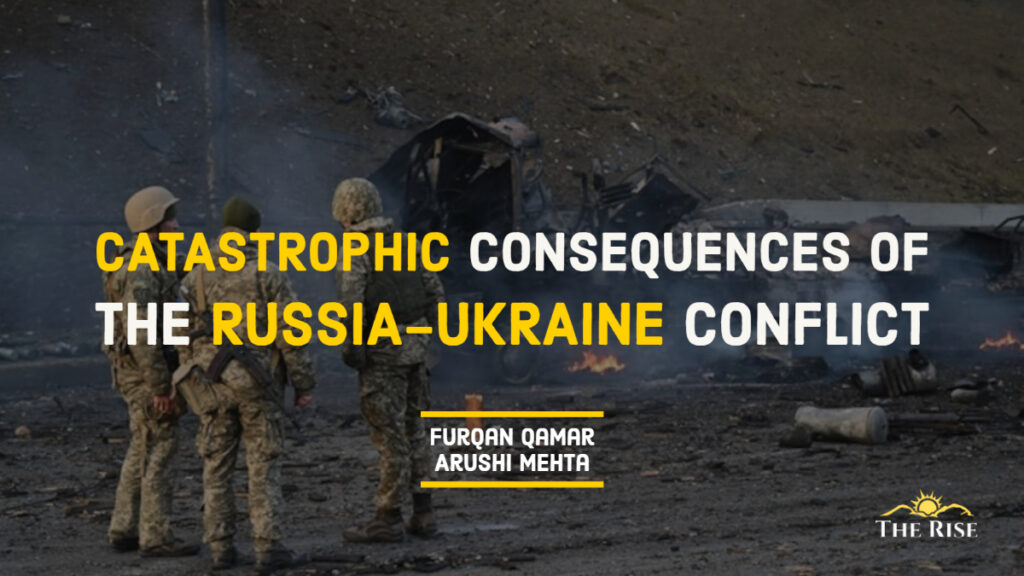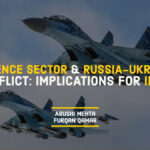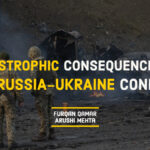The ongoing Russia-Ukraine conflict has had a long history and with threat perceptions on both sides. However, the conflicts and wars benefit only a few, and that too in the short term. The world must work together to end this crisis at the earliest. Or else, its cascading effect might push the whole world into an abyss from where the recovery would become extremely difficult. The underdeveloped and the developing world are likely to be the worst affected and they all must come together to pitch for peace.
Just when the Indian and the world economy were showing signs of recovery, they were jolted by Russia’s attack on Ukraine and consequent sanctions against Russia by the western world. The conflict has cast a huge shadow on the economic outlook and has wide-ranging ramifications for the world economy, particularly the European Union (EU) and the United States of America (USA). Hopes and efforts for an early solution to the crisis have failed to fructify so far. The conflict has already entered its third month and there are no signs that it would end soon.
Many European countries which have so far been maintaining neutrality are now seriously reconsidering their decision and want to become members of the EU. Some of these have long borders with Russia and that has enhanced its threat perception. Obviously, Russia is not likely to take the developments lying low or quiet. Consequently, the chance of the conflict extending and prolonging has become more pronounced. We can only hope and pray that the diplomacy works, and sanity prevails.
Ukraine has suffered a massive loss of life and destruction of infrastructure leading to a mass exodus of its citizens not only to the less affected regions within the country but also to many other neighbouring countries. Reportedly, over 5 million Ukrainians have been compelled to take refuge in Poland and many other European countries.
Also Read: Defence Sector During Russia-Ukraine Crisis: Implications for India
UK has frozen the assets of five Russian Banks and their oligarchs. Germany has suspended certification of the Nord Stream 2 gas pipeline US has cut off Vnesheconombank (VEB) and Promsvyazbank (PSB) from its financial system. Japan has imposed export controls on semiconductors and other dual-use goods to Russian entities.
Sanctions on Russia
The conflict has already exerted upward pressure on prices due to the global supply chains disruption. Particularly hit have been the prices of crude oil, metals, and other key commodities (Business Today, 2022). These are posing serious challenges for governments all over the world at a time when they were struggling to revive growth and recovery. Russia has been reeling under the economic sanctions imposed upon it by the US and the western world. Russia has not only intensified its attack on Ukraine but has also responded by taking countermeasures. These steps and counter-steps will severely impact world trade and the economy and will also significantly affect people and their lives. Obviously, the conflict has adversely affected not only the two warring nations and their vicinity but far and wide.
Sanctions have been imposed on Russia in three forms: on the government, banks and corporates, and individuals considered close to the ruling dispensation. European Union (EU) has frozen its assets (Bown, 2022). US has cut off Vnesheconombank (VEB) and Promsvyazbank (PSB) and their 42 subsidiaries ensuring that they can no longer do business in the US and access its financial system.
United Kingdom (UK) has frozen the assets of five Russian Banks and their oligarchs. Germany has suspended certification of the Nord Stream 2 gas pipeline which was meant to transport natural gas to western Europe. EU has also restricted Russia’s access to financial markets, effectively naming the export and import of certain services to and from Russia.
Also Read: Fallouts of Financial Sanctions Against Russia
US has banned Sberbank mandating all US financial institutions to close their accounts and reject future transactions. Assets of VTB Bank, Otkritie, Novikom, and Sovcom were also frozen (U.S. Department of the Treasury, 2022). It also restricted access to technologies like semiconductors, information security equipment, lasers, and sensors through the Foreign Direct Product Rule. Financial sanctions have also been imposed on Russian banks, defence companies, and oligarchs and also restricted exports to Russia’s strategic industries.
Over time the sanctions are getting intensified. EU, too, has imposed financial sanctions on the political leadership of Russia, other Russian individuals, and Russian banks. Property interests of Russian political leaders have also been confiscated. Japan has also frozen the assets of three Russian Banks and has imposed export controls on semiconductors and other dual-use goods to Russian entities.
The Central Bank of Russia stands excluded from the global currency market. National Wealth Fund of the Russian Federation, the Ministry of Finance of the Russian Federation, and the Russian Direct Investment Fund too are denied access to the global financial market.
British Petroleum, a major British energy company, exited Rosneft, a Russian oil and gas company, though it has suffered a $25 billion blow itself (Bousso Ron & Zhdannikov Dmitry, 2022). Microsoft, Apple, Shell, and a host of other major multinationals have either left or suspended their operations in Russia despite suffering major losses themselves.
Russian banks and financial institutions stand cut off from SWIFT, an essential payment gateway for cross-border trade and settlements. The Central Bank of Russia stands excluded from the global currency market. National Wealth Fund of the Russian Federation, the Ministry of Finance of the Russian Federation, and the Russian Direct Investment Fund too are denied access to the global financial market.
Also Read: Alternative to SWIFT: Russia-Ukraine War Highlights the Urgency
Banning Russia from SWIFT will have effects on various countries, including India (Massey, 2022). When Iran was cut off from SWIFT in 2012, its foreign trade had declined by 30 percent which was a major blow not only to Iran but also to many other economies that depended on their essentials from Iran (Hindustan News Hub, 2022). Russia is expected to suffer less serious damage as it has an alternative network Sistema Peredachi Finansovykh Soobscheniy (SPFS). This may, however, help mostly in domestic settlements. Russia is said to be contemplating linking its network with the Chinese payment gateway to mitigate the impact.
The USA has completely banned the import of Russian oil, coal, and LNG while the UK has decided to withdraw from the import of Russian oil in a phased manner by December 2022. EU is also considering the removal of Russia’s status as the Most Favored Nation from the World Trade Organization. The World Bank too has announced to stop all its programs in Russia and Belarus with immediate effect.
Russian Retaliation against Western Sanctions
The sanctions obviously have the potential of wrecking the Russian economy and squeezing its oil and gas exports, which are a major source of revenue for Russia. Expectedly, Russia has retaliated by banning exports of telecom, medical products, agricultural products, electrical equipment, and more. It has also banned the export of wheat, corn, and barley to the Eurasian Economic Union till August 2022.
Russia has also offered oil and several commodities to India at heavy discounts, which India has already decided to accept despite pressure from the US and other western countries to desist from any such temptations. A Rupee-Ruble payment mechanism, with the involvement of small Indian banks with no presence in Western countries, is also being worked out to facilitate such transactions. Russia has also reportedly offered to take care of transportation, logistics, and insurance issues.
Also Read: Russia-Ukraine Crisis: A Big Boost for Iranian Economy?
Russia has retaliated by banning exports of telecom, medical products, agricultural products, electrical equipment, and more. It has also banned the export of wheat, corn, and barley to the Eurasian Economic Union till August 2022.
Russia is the third-largest producer of crude and the second-largest producer of gas. The Russian invasion resulted in a jump in global energy prices and on the day of the invasion, i.e., 24th February 2022, the benchmark Brent crude jumped to $101.29 per barrel from $99.29 per barrel the previous day. On 8th March 2022, the price of Brent crude touched $139.39 per barrel, the highest since it reached a historical all-time high in 2008. Since then, the price of crude has come down upon satisfactory progress in talks between Russia and Ukraine to resolve the conflict and is settling at around $ 98 per barrel. However, it is still much above the Economic Survey 2021-22 assumption of $70-75 per barrel for FY23. If the price of crude remains around $100 per barrel, the Government’s projections and calculations will undergo drastic changes. The price increase will have to be passed on to the consumers and will impact India’s fuel inflation. India is one of the largest importers of petroleum products and meets almost 85 percent of its requirements through import. India is also a major importer of gas. This substantial price rise will upset India’s foreign trade and balance of payment position by increasing the Current Account Deficit.
The increase in crude oil prices is now being passed on to consumers, after a gap of nearly four months, apparently due to the elections in 5 states. This will obviously have a cascading effect on the entire economy and severally impact the household budget. The price of Compressed Natural Gas has increased marginally, whereas the price of Aviation Turbine Fuel has been sharply raised to a record high of over ₹ 1 lakh per kiloliter on 16th March 2022.
Also Read: Russia-Ukraine Crisis: The Impact on India
Russia is a key energy exporter and its conflict with Ukraine has resulted in increased energy prices. If crude oil price hovers around $100 per barrel, which is much higher than the Economic Survey 2021-22 assumption of $ 70-75 per barrel, the Government’s projections and calculations will undergo drastic changes.
Impact on India’s Food Security
This conflict has affected the global food supply chain. Russia and Ukraine have a sizeable share in the global supply of food grains. Both are major producers of wheat and their combined share in global production is about 14 percent. Both the countries are also major exporters of wheat, Russia being the largest exporter of wheat. Russia and Ukraine together account for about 29 percent of global exports. Ukraine is known as the “Breadbasket of Europe”. It exported $10.74 billion worth of cereals and $6.08 billion worth of animal and vegetable fats and oils till November 2021, as per Ukrinform.
A prolonged conflict can cause disruptions in the food supply which will affect the food security of many countries. Food inflation is also rising. There’s a possibility that many countries in Europe, the Middle East, and Africa might face a food crisis if this situation prolongs. Russia and Ukraine contribute about 4 percent each of oilseed production, 75 percent of which is sunflower seed. India is a major importer of oilseeds, particularly sunflower seeds. The annual consumption of sunflower oil in India is about 25 lakh tonnes. During 2020-21, India imported 22 lakh tones of sunflower oil, out of which 19.3 lakh tonnes were from Ukraine and 2.8 lakh tonnes from Russia.
Disruption of supplies from Russia and Ukraine has now become a major worry. It has already caused a rise in the prices of edible oils. India is already facing high food inflation and price rise will further aggravate the situation, although India is somewhat safely positioned as it can substitute sunflower oil with soyabean oil and palm oil. Moreover, mustard production in the country is also expected to be good, so the severity will be somewhat subdued.
Also Read: Russia-Ukraine Conflict: Impact on Global Flow of Funds
With Russia and Ukraine banning fertilizer exports, India will have to to consider alternatives for imports such as China, Canada, Morocco, etc. The rise in prices of fertilizers will, in turn, lead to the rise in prices of agricultural produce. In fact, rising prices within the country and a fall in wheat production have compelled India to ban wheat export.
The crisis may temporarily present opportunities for some. Other countries may increase their share of exports of these commodities in the global market. India seemed to have an opportunity of increasing its global share in wheat export. However, rising prices within the country and a fall in wheat production have compelled it to ban wheat export. India exported a $556 million value of agricultural and allied commodities to Russia in the year 2018-19. The major exports included tea, marine products, guar seeds, coffee, etc. According to the Annual Report 2020-21 of the Agricultural and Processed Food Products Export Development Authority (APEDA), Russia imported cucumber and gherkins, fresh grapes, and poultry products and was among the top 5 importers from India. Russia was also the 7th largest importer of Indian marine products as per the 2020-21 Annual Report of Marine Products Export Development Authority (MPEDA).
India imports fertilizers from Russia and Ukraine. Ukraine has suspended its fertilizer exports and some agricultural commodities like rye, oats, buckwheat, and meat and imposed licensing on its key export goods like sunflower oil, corn, and wheat fearing shortages. Russia which accounted for 13% of global output has banned the export of fertilizers. This has resulted in rising prices of fertilizers and increased volatility in supply globally.
The Green Markets Weekly North America Fertiliser Price Index has been seen rising continuously since the start of the military operations by Russia. The ban on the export of fertilizers will have a significant impact on many economies including India as it is highly dependent on imports. With Russia and Ukraine no longer in the picture, India needs to consider alternatives for imports such as China, Canada, Morocco, etc. The rise in prices of fertilizers will, in turn, lead to the rise in prices of agricultural produce.
Inflationary Pressures and Unstable Markets
The price of several metals, including base metals like copper and nickel, have increased upwards after the conflict. Nickel trading witnessed a short squeeze on London Metal Exchange and its trading was suspended on 8th March 2022 after prices saw an upward spiral of over 250 percent in just 24 hours. Russia contributes around 4 percent to commodities like iron ore, copper, and steel. Even though Russia is not a major player in these commodities, the prices of several commodities have increased due to the war. India imports iron, steel, etc. from Russia and Ukraine. India exports chemicals, machinery, pharmaceutical products, etc. to Russia. Alternative markets need to be sought for the export of these commodities in case the trade with Russia gets disrupted.
Conflicts cause uncertainty. Investors pull out from riskier assets like equities and divert their funds towards assets considered safe-haven. The present conflict is no exception. Stock markets have crashed globally and correspondingly price of gold, a safe-haven asset, started rising. Around the world, the stock markets panicked and closed lower on the day of the invasion. In Russia, the Moscow Stock Index tanked by nearly 50 percent.
In India too, the investors pressed the panic button and Sensex closed 2702 points down, its fourth-biggest single-session loss ever. Subsequent to the initiation of talks between both warring countries, indexes across the world have started recovering gradually and are recovering lost ground. The same situation prevailed in India too. After a brief recovery, however, the markets are fast losing momentum once again due to inflation, macro trends, and frightening political turmoil in India’s neighbourhood.
Also Read: Bracing for the Changing Geopolitics: Ukraine Crisis and Energy Security in India
The freight rates, too, are expected to increase due to higher oil prices as well as looming uncertainty over insurance cover. As war is not covered under insurance policies, exporters are apprehensive that logistics challenges will increase, especially in Ukraine. The Black Sea is of strategic importance as Russia and Ukraine both are major contributors to oil and agricultural products. The Ukrainian port of Kherson has been captured by Russia. These disturbances will lead to less or no cargo movement, affecting the logistic supply chain. This invasion will also impact the insurance sector.
War as a risk is excluded from most covers. Sanctions also affect insurance and reinsurance rates as they will have a direct relation with the underwriting of risks from the two countries. Insurers have stopped covering air carriers and merchant ships and vessels sailing in the region or are demanding high premiums. Ships sailing in the Black Sea are also not covered or insurers are charging very high premiums for the risk coverage.
Also Read: The Lessons for Taiwan from Russia-Ukraine Conflict
Global investors are already withdrawing from emerging economies, including India, and investing their funds in a more stable economy. Rupee depreciation will result in higher realisation for exporters. However, it will also lead to rise in inflation due to an increase in import bills which will further increase the trade deficit.
Uncertainties are pushing jittery investors the world over to look for safe-haven assets like gold, USD, and US government bonds. As a result, the dollar rallied against most other currencies and the yields on 10-year US Government Bonds came down to 1.87 percent level, which incidentally was at a multi-year level of about 2.07 percent just a week ago. Global investors are already withdrawing from emerging economies, including India, and investing their funds in a more stable economy. Due to the flight of capital, demand for dollar might increase and it will become stronger. Although Rupee depreciation will result in higher realisation for exporters, it will also lead to rise in inflation due to an increase in import bills which will further increase the trade deficit. The foreign borrowings made by corporates will also become expensive and their servicing costs increase. This will also be disadvantageous to importers.
In the ultimate analysis, the conflicts and wars benefit only a few and that too in the short term. They serve no one’s long-term interests. The present conflict has had a long history and with threat perceptions on both sides. The world must work together to end the crisis at the earliest. But for this, the cascading effect of the crisis might push the whole world into an abyss from where the recovery would become extremely difficult. The underdeveloped and the developing world are likely to be the worst affected and they all must come together to pitch for peace.
Disclaimer: The views expressed in this article are of the authors solely. TheRise.co.in neither endorses nor is responsible for them.
















Sir the Russia – Ukraine war is also worsening the deadly famine in the horn of Africa. The global food chain disruption is hurting African countries like Ethiopia, Somalia and Kenya who import 90% of their wheat from Russia and Ukraine.
Pingback: Iran and Venezuela on Cooperation Road - TheRise.co.in
Pingback: All That Glitters is Gold Indeed - TheRise.co.in
Pingback: Significance of Neutrality for Ukraine - TheRise.co.in
Pingback: Crossing China's Red Line: Pelosi visiting Taiwan - TheRise.co.in